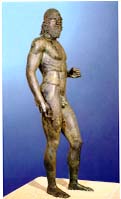![]()
 At Rome
in September 167 B.C. Consul Aemilius Paullus celebrated his triumph in the plain of
Pydna, near the Gulf of Salonika, where the Romans had routed the Macedonian army whose
fearsome phalanx formations were no match for the Romans. The battle claimed the lives of
twenty thousand Macedonians. The spoils of war amounted to the then unheard of figure of
210 million sestertia: ancient Rome celebrated the vietory with a hitherto unknown
splendour and opulenee, with parades of prisoners and slaves, carts of valuable plunder -
the city was poised to become the absolute master of the Mediterranean and the East.
At Rome
in September 167 B.C. Consul Aemilius Paullus celebrated his triumph in the plain of
Pydna, near the Gulf of Salonika, where the Romans had routed the Macedonian army whose
fearsome phalanx formations were no match for the Romans. The battle claimed the lives of
twenty thousand Macedonians. The spoils of war amounted to the then unheard of figure of
210 million sestertia: ancient Rome celebrated the vietory with a hitherto unknown
splendour and opulenee, with parades of prisoners and slaves, carts of valuable plunder -
the city was poised to become the absolute master of the Mediterranean and the East.
Greece was now divided and subjugated, its art treasures were being pillaged on an
unprecedented scale: art traders and brokers were now all too common figures and there was
a proliferation, particularly at Athens, of schools which copied, vulgarised and adapted
ancient masterpieces.
It was now almost obligatory for a rich Roman to own Greek statues, mostly good copies,
while the prestigious originale were generally the reserve of the richest and most
powerful. Ships loaded with precious works set sail from the ports of Greek, and this
traffie became a source of unexpeeted wealth for many: in 146 B.C., Corinth was plundered,
the city destroyed and burnt to the ground. Its uncouth conquerer Lucius Mummius acquired
its works of art and exacted that those charged with transporting the plundered works to
Italy replace them with other works should they be damaged or lost during shipment. Some
decades later, five legions under the command of Sulla and a fleet of 1,600 vessels landed
in Grecce and laid siege to Athens.
The city and its acropolis were reduced to famine by a long siege and were barbarously
sacked in the spring of 86 B.C.
 Sulla, who recovered from the fatigues of the war at the baths of the island of Euboea,
organised the plundering of the works of art.
Sulla, who recovered from the fatigues of the war at the baths of the island of Euboea,
organised the plundering of the works of art.
The columns of the Olympieion were shipped to Rome where they would be used for the
reconstruetion of the temple of Jupiter Capitolinus in Rome, the treasures of Delphi,
Olympia and Epidaurus were pillaged and, together with the entire library of Apellikon of
Theos, which included many manuscripts by Aristotle, found their way to Rome.
They were shipped by sea, navigating along the lonian coasts of Calabria and it was not
uncommon for the strong winds and treacherous rocks to cause shipwrecks, In the Satyricon,
Petronius Arbiter tells that Lica's vessel sank near Kroton and there are numerous other
re- ports of shipwrecks along the Calabrian coasts.
We do not know when or why, whether as booty or to satisfy the desires of some 'nouveau
riche', but the ship which was carrying two superb bronze statues portraying two warriors
and destined for sale in Rome, came to grief at sea off the town of Riace near Punta
Stilo. The crew fought for a long time to counter the fury of the winds and save the
precious cargo, but when they realised that there was little left to do and that the heavy
statues would cause the ship to sink, they cast the statues into the sea, thus bidding
farewell to their hopes of a good profit.
Perhaps while one of the two statues was about to be thrown over the side, one of the crew
realised that its Corinthian helmet was gold-plated: the helmet was wrenched from the
statue's head as a last chance to make money from a ill-fated undertaking.
The two statues slowly sank to that seabed which for almost two thousand years was to be
their home, the ship carrying them probably fared no better, its mast broken by the fury
of the winds, its sails reduced to rags, it sank not far from the coast, thus preservino
for ever the secret of where the two bronze masterpieces rested.
No record of the statues has ever been found.
![]()